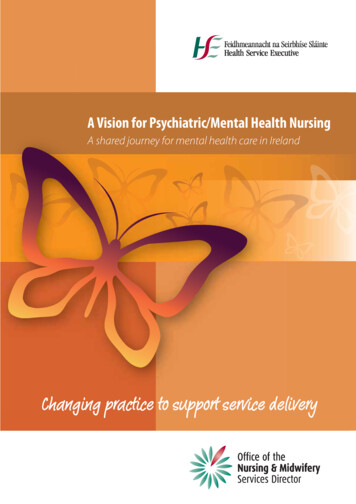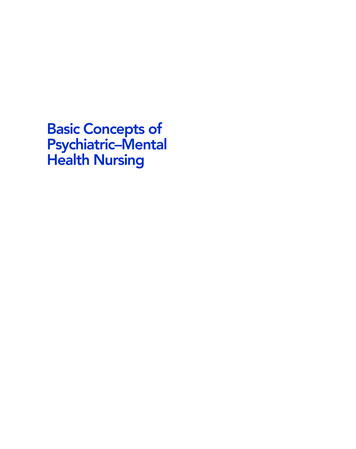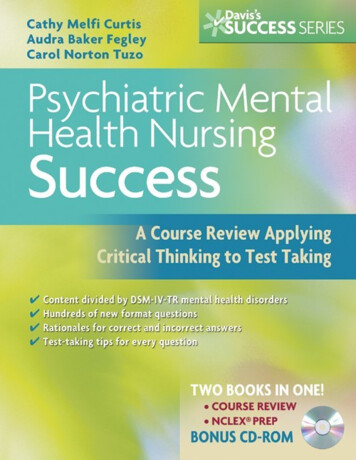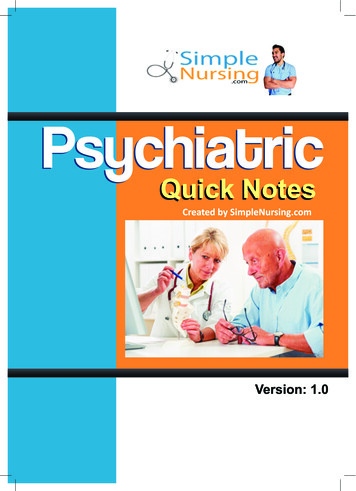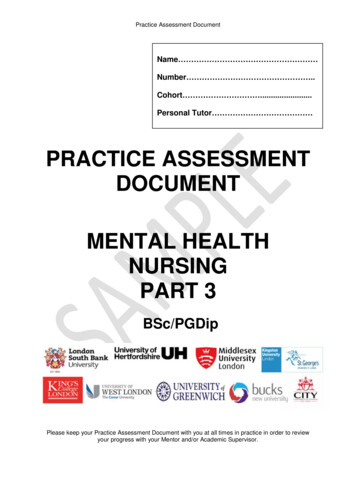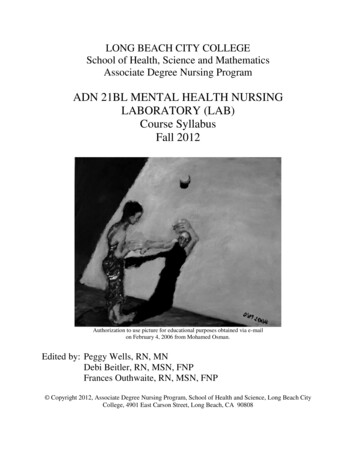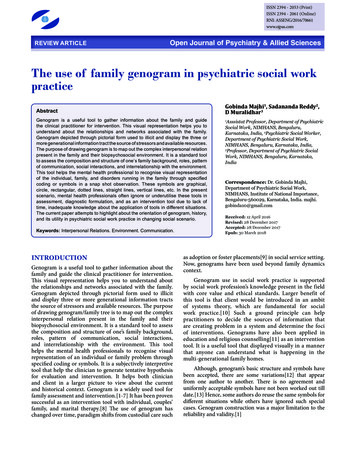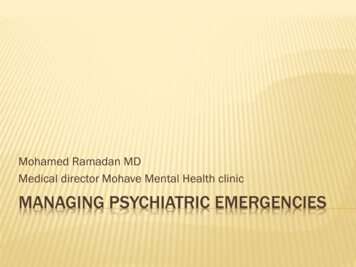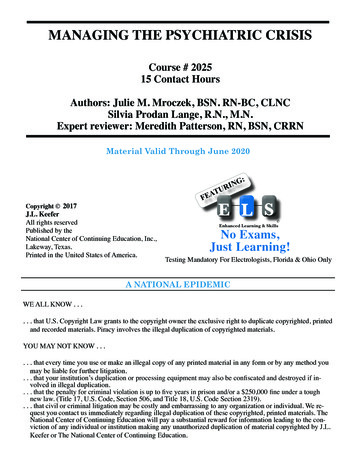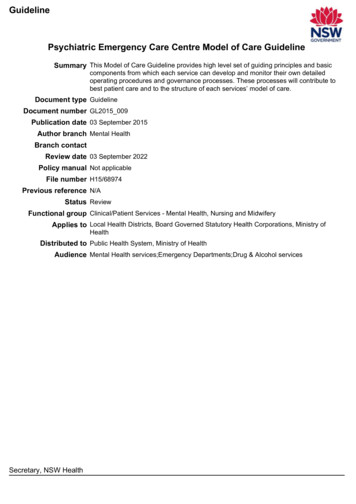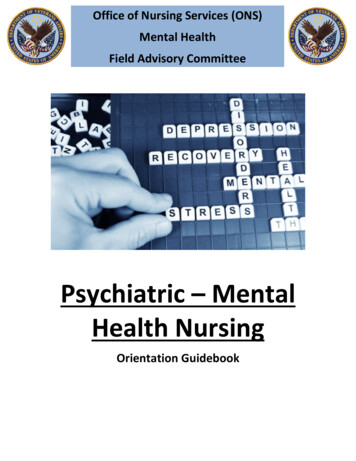
Transcription
Office of Nursing Services (ONS)Mental HealthField Advisory CommitteePsychiatric – MentalHealth NursingOrientation Guidebook
Office of Nursing Services Mental Health Field Advisory CommitteeAcknowledgementsThe members of the committee wish to thank the leaders of Office of Nursing Services (ONS)for developing the Clinical Practice Program and providing the resources to make thispublication possible. We are grateful to Dr. Elizabeth Czekanski, Mental Health Clinical NurseAdvisor, for the support, leadership, and guidance provided. This work was developed in thespirit of the ONS mission and vision for excellence in nursing care and we are pleased to offer itto our nurse colleagues.Field Advisory Committee members include:MH FAC Advisor: Elizabeth Czekanski, DNP, MS, RN-BC, NE-BC, VHA-CMKayla Cross, RN-C, MSN, MA (Editor in Chief)Carol Essenmacher, DNP, PMHCNS-BC, C-TTSNancy Faulk, PhD, RN, CNS, NE-BCKarin Glenn, DNP, RN, PMHNP-BCKristine Theis, FNP, MSN, RNMelissa Smith, RN-BC, MSNAnne Marie Craman, RN, MSN, PMHCNS-BC, NE-BCKat Zervas, RN, MSN EducatorSpecial thank you to the former Field Advisory Committee members:Carol Hawthorne Rumpler, MS, PMHCNS-BCBernadette Y. Jao, DNP, MSN, RN-BCSharon Valente, PhD, APRN-BC, FAANDoris C. Vallone, PhD, PMHCNS-BC
Veterans Health AdministrationOffice of Nursing ServicesMISSIONThe Office of Nursing Services provides leadership, guidance, and strategic direction on allissues relating to nursing practice and nursing workforce across the continuum of care. ONS iscommitted to aligning nursing strategic goals with field-based operation and organizationalpriorities.VISIONVA Nursing is a dynamic, diverse group of honored, respected, and compassionateprofessionals. VA is the leader in the creation of an organizational culture where excellence innursing is valued as essential for quality healthcare to those who served America.
Table of ContentsModule1: SafetyInpatient Mental Health Environment of CareTherapeutic MilieuModule 2: CommunicationTherapeutic CommunicationNurse-Veteran RelationshipDocumentationModule 3: Patient Centered CareRecoveryCultureAdvanced DirectivesEthicsNurse Led Psycho-educational GroupsPeer SupportTrauma Informed CareModule 4: Psychiatric Nursing AssessmentPsychiatric Nursing AssessmentSuicide Risk AssessmentPainSubstance Use and Withdrawal AssessmentDisruptive BehaviorModule 5: Mental Health DisordersPost-Traumatic Stress DisorderDepressive DisorderBipolar DisorderSchizophrenia Spectrum and other Psychotic DisordersSubstance Use Disorder (SUD)Module 6: PsychopharmacologyAntipsychoticsMood StabilizersAntidepressantsAnxiolyticsModule 7: Professional DevelopmentCertificationTraining and ResourcesMentoringAppendix A – List of Potentially Hazardous ItemsAppendix B – Evaluation of the Therapeutic Milieu ExemplarAppendix C – Unit Guideline Consent ExampleAppendix D – Community Meeting TemplateAppendix E – Treatment Program Schedule and Progress Log ExampleAppendix F – Assessment Documentation ExampleAppendix G - Sample Group Note
Appendix H – Group Note TemplateAppendix I – Treatment Plan Process CrosswalkAppendix J – Nursing Interventions in the Acute SettingAppendix K – Review of PsychopharmacologyAppendix L – Glossary of Mental Health Terms/Phrases
1Module OneSafetyObjectives1.2.3.4.5.Identify the safety assessment process for the inpatient environment of care.Discuss options for maintaining a safe environment of care.Define “Therapeutic Milieu”.Assess practice setting using the questions provided.Assess your personal attitudes related to the therapeutic milieu.IntroductionThe creation and maintenance of a safe environment in the acute inpatient psychiatric setting isthe cornerstone of the psychiatric – mental health nurse’s (P-MHN) role and responsibility. Therole of the P-MHN to assess for environmental and individual safety is active and on-going inorder to prevent self-harm or harm to others in the hospital setting. The P-MHN has aresponsibility in creating and supporting a therapeutic milieu which incorporates the elementsof safety, support, and structure, while creating a social environment that encourages selfunderstanding and validation of feelings. The acute psychiatric environment of care (EOC),which promotes safety and recovery, is imperative to optimize patient outcomes. This modulewill review the environmental and clinical assessment process for nurses in the acutepsychiatric setting.Inpatient Mental Health Environment of CareSuicide attempts and suicide completion continue to occur in the acute inpatient psychiatricsetting in hospitals across the U.S. The physical environment is the root cause of the majority
2of inpatient suicides. While suicide on VA inpatient mentalhealth units is extremely rare, hanging continues to be themost common method for inpatient suicide.Nursing staff are responsible to create and maintain a safeenvironment of care on the acute inpatient unit. Nurses areaware of the potential areas of risk or harm to the Veteranand mitigate that risk through assessment, monitoring, andintervention. During construction of new units or renovationof existing units, nursing staff should be involved in theplanning and design process to help anticipate areas of riskand promote a safe and recovery oriented milieu.Safety and the Mental Health Environment of Care (MHEOC): The physical environment on anacute inpatient unit is important to mental health treatment and must support recovery. Theenvironment must represent hope, healing, and wellness while maintaining safety (Departmentof Veterans Affairs (VA), 2013). A safe MHEOC is important for the health and wellbeing ofVeterans and staff. Safety features can be built into the MHEOC as a preventive measure butultimately, safety relies on constant staff awareness, action and communication.Safety relies on the clinical expertise of unit staff who utilize the therapeutic relationship,milieu management, and safety management systems in place to maintain a safe and secureenvironment.Nursing staff provides 24/7 care to inpatient Veterans. They are responsible for assessing andmaintaining unit safety and promoting a therapeutic milieu. Staff awareness and mindfulnessof safety and the MHEOC are paramount. Concerns are promptly communicated to the entireteam to be immediately addressed.Safety AssessmentSuicide prevention on an acute inpatient unit must be an all staff/all shift effort, 24/7. Mostinpatient suicides occur on the 2nd and 3rd shift, so all shifts must be actively involved in ongoingrisk assessment. Involvement of all staff takes the risk assessment and safety outcomes out ofthe hands of a few and places it on the shoulders of the entire mental health team.Creating a safe environment of care requires a clinical assessment by the P-MHN. The MHEOCassessment is an extension of the patient assessment, completed to promote safety andmitigate individual risk for harm. The combination of clinical assessment and environmentalassessment maximizes unit risk reduction efforts. Initial and ongoing clinical assessmentremains the single best method for identifying individuals at risk for hurting themselves orothers. This coupled with the MHEOC assessment and promotion of a safe space for healingsupports individual and group recovery on the acute inpatient unit.
3Part of the MHEOC assessment is identifying which objects are hazardous items, formerlyidentified as ‘contraband’, and have the potential to result in harm to the Veteran. Identifyinghazardous items (see Appendix A for sample list) and reducing access to potential hazards inthe environment is crucial for the safety of all on the unit. Checks for hazardous items must beperformed at time of admission and as clinically appropriate per facility policy (e.g. whenVeterans return from off-unit activities and when Veterans have been with visitors). Theprocess must be respectful and sensitive to Veteran dignity while ensuring that items whichmay create a safety risk are not brought onto the unit. Such checks must be conducted in aprivate and secure area. If a bodily search is conducted, such as the use of a wand, the searchmust be conducted by a staff the same gender as the Veteran. Staff must have documentedtraining in how such searches must be conducted (VA, 2013, p. 11).Once a safety issue is identified, the P-MHN must take immediate action to provide a saferesolution. The nurse must use sound clinical judgment, critical thinking, systems thinking, anda team approach to resolve the problem to eliminate further threat to environmental safety.When risks are identified and hazardous items are removed, it is important to communicatefindings and outcomes to the entire team to promote ongoing unit safety.Environmental AwarenessPromoting environmental safety and assessing/reassessing the MHEOC is paramount. All staffmust be alert to safety issues within the acute MHEOC and communicate frequently with theteam. Environmental awareness includes awareness of team members’ locations, maintainingaccess to exits, recognizing environmental safety challenges (e.g. visitors or external staff onthe unit - housekeeping, engineering, contractors, etc.), and creating an awareness ofpotentially hazardous items and spaces.Maintaining a safe environment starts as soon as the Veteran reaches the unit. Nursing staffcomplete an initial search and inventory of Veteran belongings (per facility policy) and identifyand secure any potentially hazardous items to prevent their presence in the milieu. Potentiallyhazardous items deemed medically necessary require a monitoring plan to ensure devices arestored properly and securely out of the milieu when not in use. Veterans with medicalequipment must be properly monitored. Medical equipment/devices not in active use can be apotential hazard to other Veterans with access to it. Medically necessary items that could behazardous include but are not limited to Continuous Positive Airway Pressure (C-PAP)equipment, oxygen tanks and tubing, Foley tubing, wheelchairs, hospital beds, splints, canes,etc.Once the safe environment is created, it must be maintained by screening other potentialavenues for introducing potentially hazardous items to the unit. Nursing staff must be vigilantregarding introducing potentially hazardous items (also referred to as contraband) into themilieu. This can include screening visitors for potentially hazardous items, being mindful ofexternal hospital staff inadvertently leaving supplies in Veteran areas (tourniquets, gloves,housekeeping chemicals, engineering tools, supplies, etc.), monitoring Veterans returning from
4off-unit activities, etc. Nearly any item regularly found in a medical hospital can be hazardousin the environment of an acute psychiatric unit. This is a typical Urgent Care or medical patientroom; can you find all of the potentially hazardous items in this picture? (Hint - there are 25!)In addition to preventing potentially hazardous items from entering the unit, it is important toroutinely and randomly reassess the environment of care and ensure it is safe. This includescompleting room checks (routine and/or focused or random checks), environmental rounds(per facility policy) throughout the shift, and having nursing staff present in the milieu toanticipate safety problems or identify potentially hazardous items or situations.Tools to Promote Environmental SafetyThere are tools offered to support and enhance the application and provision of a safeenvironment of care on the acute psychiatric unit. Familiarize yourself with these tools andutilize them to support the safe MHEOC:Mental Health Environment of Care Checklist nals/onthejob/mentalhealth.asp): Identify and eliminate environmental risks forinpatient suicide and suicide attempts. Increase the awareness of clinical staffregarding environmental hazards onpsychiatric units. Focus specific attention on psychiatric unitsafety, above and beyond routine facilitysafety inspections.The MHEOCC was implemented in 2008 and isdesigned to identify and address environmental risksfor inpatient suicide and suicide attempts in the VA. Itis only one part of a comprehensive system to reducesuicide in our veteran population. It is critical that facilities have reliable protocols for
5identifying veterans at risk for suicide, assessing the level of suicide risk, and providingappropriate treatment for suicidal Veterans.Design Guide (http://www.cfm.va.gov/til/dGuide/dgMH.pdf): Promotes new building design that is recovery-oriented, patient centered, safe. Promotes a sense of calm in Veterans and enhances the connection to theirsurroundings.Mental Health Guide(http://www.patientsafety.va.gov/docs/joe/eps mental health guide.pdf): Offers products and solutions to create a safe and therapeutic environment. Provide products and ideas to use in the inpatient acute setting, citing positive andcautionary attributes to consider prior to purchase.Therapeutic MilieuA therapeutic milieu is a treatment environment in which all aspects have purpose andcontribute to recovery. Providing for a therapeutic environment is a core function of apsychiatric-mental health nurse (P-MHN) (American Nurses Association, American PsychiatricNurses Association, and International Society of Psychiatric Nurses (ANA, APNA & ISPN), 2014).The therapeutic milieu is a purposefully created therapeutic environment that supports mentalhealth recovery. There are five essential processes addressed in constructing and maintainingthe therapeutic milieu: safety, support, structure, social involvement, and validation/selfunderstanding (Gunderson, 1978; LeCuyer, 1992). The new P-MHN must reflect and considerhis/her role in each of the processes. The function of each process is described along withsample questions to assist in assessing the dynamic quality of the therapeutic milieu. Pleasesee Appendix B “Evaluation of the Therapeutic Milieu” to ap
Psychiatric Nursing Assessment. Suicide Risk Assessment Pain. Substance Use and Withdrawal Assessment Disruptive Behavior. Module 5: Mental Health Disorders . Post-Traumatic Stress Disorder . Depressive Disorder Bipolar Disorder. Schizophrenia Spectrum and other Psychotic Disorders Substance Use Disorder (SUD) Module 6: Psychopharmacology. Antipsychotics. Mood Stabilizers.

